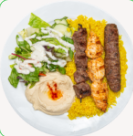Among the sea of varieties of Arabica coffee beans, the Turkish coffee is favoured among coffee lovers all around the world. Although the Arabica green beans for Turkish coffee have a lot of health benefits, today we will focus only on Turkish coffee. Turkish coffee is renowned for its unique preparation and rich flavours. One of the most distinctive aspects of Turkish coffee is its wide range of varieties. With varieties spread over Blatic as well as in other European nations, it became popular and took many of the cultural aspects of the land where it went. The diverse flavours has resulted in coffee enthusiasts to buy Turkish Arabica coffee wholesale. In this article, we’ll take a journey through the diverse types of Turkish coffee, each with its own characteristics, preparation methods, and regional variations.
7 types of Turkish Coffee
In all accordance, nothing beats the scent and flavour of freshly brewed Arabica beans (wholesale) in the morning. Turkish coffee, from the days of the Ottoman empire, served in traditional copper pots is just another drink that’s enough to get a strong start to the day.
Let’s take a look at the seven most delicious flavours of Turkish coffee:
- Traditional Turkish Coffee
The traditional Turkish coffee, known as “Türk kahvesi,” is the foundation of all Turkish coffee types. It’s a finely ground, unfiltered coffee made from Arabica beans. It’s prepared using a special coffee pot called a “cezve” and is often served with a small piece of Turkish delight. The Arabica green beans for Turkish coffee is also used for many health purposes. The key to its rich flavour lies in the meticulous preparation process.
- Mastic Coffee
Mastic coffee, or “damla sakızlı kahve,” is a delightful variation that includes mastic resin, which adds a distinct piney aroma and a unique chewy texture to the coffee. It’s especially popular in Aegean and Mediterranean regions with people often buying Turkish Arabica beans wholesale.
- Cardamom Coffee
Cardamom coffee, known as “kakuleli kahve,” is flavored with aromatic cardamom seeds. This variety offers a fragrant and slightly spicy twist to the traditional Turkish coffee, making it a popular choice among those who appreciate a hint of exotic spice in their coffee.
- Salep Coffee
Salep coffee, or “sahlep kahvesi,” is a winter favorite. Instead of regular coffee, it’s made from salep powder, which is derived from the roots of a specific type of orchid. It has a thick and creamy consistency and is often garnished with cinnamon, making it a warming and comforting drink during the colder months.
- Dibek Coffee
Dibek coffee, “dibek kahvesi,” is traditionally ground in a mortar and pestle, and the coffee beans are roasted with various spices like cloves, cinnamon, and cardamom. The result is a robust and aromatic coffee with a complex flavor profile.
- Turkish Coffee with Milk
Known as “sade kahve” or “az şekerli kahve,” this is a variation of Turkish coffee that includes milk. It’s milder in taste compared to the traditional version and is often prepared with various levels of sweetness to suit individual preferences.
- Turkish Coffee with Chocolate
For those with a sweet tooth, Turkish coffee with chocolate, or “kahve keyfi,” is a delightful choice. This variation combines the bitterness of coffee with the richness of cocoa, creating a harmonious blend that is perfect for dessert.
Preparations of some renowned Turkish Coffee
Traditional Turkish Coffee
To truly appreciate the diversity of Turkish coffee recipes, we must begin with the classic, time-honoured preparation. The traditional Turkish coffee is a strong, black coffee brewed from very finely ground coffee beans. It’s rich in Magnesium and potassium and helps in regulating blood sugar levels and utilising insulin similar to Arabica green beans for Turkish coffee. Here’s how it’s made:
Ingredients:
Finely ground coffee beans
Cold water
Sugar (optional)
Cardamom (optional)
Steps:
● Measure one heaping teaspoon of finely ground coffee per cup and add it to a special small pot known as a “cezve.”
● Add cold water, typically using the same coffee cup, to the cezve. One cup of water per cup of coffee is a common rule of thumb.
● Optional: add sugar before brewing, and cardamom for an extra layer of flavour to enhance the taste.
● Stir gently to mix the coffee with the water and other ingredients.
● Place the cezve on low heat and let it slowly come to a boil. This process should take around 5-7 minutes.
● Just as it begins to foam and rise, remove it from the heat. Let it settle for a moment.
● Return the cezve to low heat, allowing it to foam a second time, then remove it from the heat once more.
The result is a thick, sludgy coffee, often served in a small cup without milk. It’s accompanied by a glass of water to cleanse the palate between sips and a piece of Turkish delight for a touch of sweetness.
Mastic Coffee: Misk Kahvesi
For those looking to explore unique and aromatic flavors, Mastic Coffee, or Misk Kahvesi, is an exciting option. Mastic resin, extracted from the mastic tree, is the key ingredient that sets this coffee apart.
Ingredients:
Finely ground coffee beans
Cold water
Sugar
Mastic resin
Steps:
● Brew Turkish coffee as usual, following the traditional steps.
● While the coffee is brewing, dissolve a small piece of mastic resin in a teaspoon of hot water.
● Remove the coffee once it’s been brewed and add the mastic resin mixture and stir well.
The resultant coffee is perfect for an energetic start to your day with its unique flavour profile and an earthy aroma.
Conclusion
Turkish coffee is more than a beverage; it’s a cultural experience that has evolved into various delightful forms. From traditional coffee and unique regional variations to Arabica green beans for Turkish coffee, it offers something for every palate. Whether you prefer the rich aroma of cardamom or salep, exploring these varieties of Turkish coffee is a journey through traditions.
















